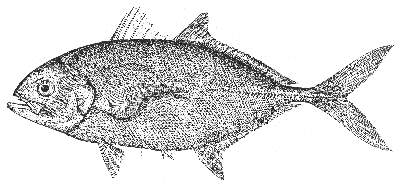Hardtail Caranx crysos (Mitchill) 1815
YELLOW JACK; RUNNER; YELLOW MACKEREL
[Jordan and Evermann, 1896-1900, p. 921.]

Figure 201.—Hardtail (Caranx crysos). Woods Hole. From Goode. Drawing by H. L. Todd.
Description—
The hardtail resembles the crevalle, saurel, and goggle-eyed scad in the relative sizes and arrangement of its fins, in its deeply forked tail, in its slender caudal peduncle and in the presence of a row of bony shields along at least the rear part of its lateral line. But its scaly breast, the lack of canine teeth in its lower jaw, and the lack of a black spot on the pectoral fin separates it from the first of these; the fact that the bony plates increase in size, passing rearward along the lateral line, marks it off from the saurel, and its strongly arched lateral line from the goggle eye. Its first dorsal fin has 8 spines, its second, one spine followed by 23 to 25 rays, while its anal consists of a finlet of 2 short spines followed, after a distinct gap, by the soft portion with 19 to 21 rays.
Color—
Greenish bronze above, golden or silvery below. The fins may show dusky cloudings, and there usually is a dark spot on the gill cover, near the margin, but none on the pectoral fin. Young fry are more or less distinctly cross-barred on the sides, but these bars disappear with growth.
Size—
Maximum weight about 4 pounds and length about 22 inches. Northern examples are seldom more than a foot long.
General range—
Atlantic coast of America, Brazil to Rhode Island and to Nantucket Sound regularly, and as far northward as outer Nova Scotia as a stray; represented by a closely allied species in the Pacific.
Occurrence in the Gulf of Maine—
The fact that this fish has been reported at Chatham on Cape Cod in 1933,[67] at Provincetown, in Boston Harbor, [page 377] off Gloucester,[68] and in Ipswich Bay,[69] and that 11 specimens, about 6 to 8 inches long, were taken in a fish trap at Barnstable on the shore of Cape Cod Bay on September 6, 1950, shows that it is more likely to round Cape Cod than is the crevalle. It is also reported from outer Nova Scotia.[70] Young fish are not rare about Woods Hole and thence westward from July to November.
[67] MacCoy, Bull. 70, Boston Soc. Nat. History, 1934, p. 6.
[68] One netted September 18, 1878.
[69] Specimen now in the collection of the Boston Society of Natural History.
[70] A 5-inch, specimen is reported from Port Mouton by Leim (Proc. Nova Scotian Inst. Sci., vol. 17, 1930, No. 4, p. xlvi), and small ones from Pubnico and near Halifax, by Vladykov (Proc. Nova Scotian Inst. Sci., vol. 19, 1935, p. 4).